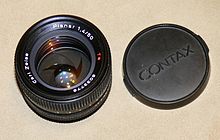Zeiss Planar
 | |
| Introduced in | 1896 |
|---|---|
| Author | Paul Rudolph |
| Construction | 6 elements in 6 groups |
| Aperture | f/1.4 |
The Zeiss Planar is a photographic lens designed by Paul Rudolph at Carl Zeiss in 1896. Rudolph's original was a six-element symmetrical design.
While very sharp, the lens suffered from flare due to its many air-to-glass surfaces. Before the introduction of lens coating technology the four-element Tessar, with slightly inferior image quality, was preferred due to its better contrast. In the 1950s, when effective anti-reflective lens coatings became available, coated Planars were produced with much-improved flare. These lenses performed very well as normal and medium-long focus lenses for small and medium format cameras. A classic Planar design is the 105mm f/2.5 Nikkor produced from 1971 to 2006. One of the most notable Planar lenses is the high-speed f/2.0/110 mm lens for the 2000- and 200-series medium format Hasselblad cameras.

